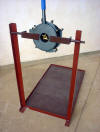|
Cinnamon Processing and Quality Assessment
A new approach to cinnamon processing Cinnamon plants are grown in bushes. Plant grows to a height of 10 to 15 m with a stem girth of 30-50 m under natural conditions. In plantations when the plants are pruned and chopped from time to time it could be maintained as a bush. When the seedlings attain the age of two years to grow to a height of about 2 m and girth around 3-6 cm they are ready for harvesting. Peelers go to the plantation in the morning and collect the stems sufficient for the day’s work. Transport to the peeling sheds is done by hand, bicycles, two wheel tractors or carts. Technological process currently adopted in Sri Lanka for cinnamon processing is given in the chart
Harvesting on May-August (Mahamosama).During this period bark peels off easily. Harvesting begins early morning, 5.30-6 am. Skilled peeler visually identifies maturity and keeps several immature shoots for the next harvest. The peeler makes a cut and lifts the bark to test bark detachment. If there is any difficulty in peeling, the peeler rejects the shoots.
Figure 1 After harvesting and removing leaves the sticks are collected, tied and carried to the open area for further cleaning. Peelability of bark is low during fruits bearing and late flushing periods. In General cinnamon can be harvested through out the year except during the above mentioned periods which in average is about two months. Peeling is quite difficult during the dry periods when soil moister depletes. Adoption of mulching practices with cinnamon leaves is a good practice to conserve soil moisture. . All the harvesting operations are done by a simple tool Ketta , it has a very sharpen blade and long handle. The blade is made of quality steel and local blacksmith usually fabricate it from a disposed leafspring.
Figure 2 Peeler holds the stick in one hand and works with other hand with Ketta along the stick remove all the knots. Usually men are engaged with this job at standing or sitting position. After removing knots, scratch should be a button shape. (figure 2)
Figure 3 Scraping is the cleaning or removing the outer cocky tissue layer from the sticks. It is not laborious but time consuming Traditional hand tool “ Kokatta” is used for this.. There are two types of tools, one with curved sharpen blade and other with a blade and small handle. That is called Sawthtuwa. Curvature of the blade is selected to mach the diameter of the sticks. Some time people use two or three scraping tools with different curvature for efficient scraping. Understanding the physical quality of the sticks (roughness, maturity) is very important for proper scraping. Therefore mechanization of this step is complicated. Stillness and physical properties of the sticks (stick diameter, number of knots, straightness ...etc) are effecting the scraping time. Figure 4 A. Traditional Kokatta Brass Rod for rubbing B. Modified Kokettaa
Figure 5 Historically bark was detached without rubbing. Subsequently a piece of Wooden rod (Keppitiya kotu) was used for rubbing. Then a copper rod was used , which was subsequently replaced by brass rod. Average diameter, length and weight of the brass road is 15mm, 20.3 cm, 110g respectively. Rubbing is the most laborious step in cinnamon processing which helps to detach the bark from the stick. Time taken for rubbing vary with the diameter of the sticks, crookedness and other abnormalities, number of knots, season, cultivars…etc. During the off season extra effort has to be applied for rubbing. After 4-6 hrs of rubbing, performance of the peeler falls down resulting bark damage and producing poor quality quills. Peelers usually change their posture to prevent muscle pain. About 40-60 strokes have to be applied around selected length of the sticks for proper rubbing and 9-30 N of vertical force have to be applied during rubbing. During the rubbing process bark sap oozes, which indicates the proper rubbing (figure 5B). Extreme rubbing damage the bark.
Figure 6 This is the skilled and time consuming step in cinnamon processing. Just after rubbing, stick is examined to decide the maximum length of bark portions that can be peeled off to make outer cover of the quills. Then make two cuts around the sticks with maximum length of intervals using a small pointed knife. Then draws longitudinal slit form end to end and works the knife carefully between the bark and hard wood to raise the bark. Finally draws the other longitudinal slit opposite to the first slit. Bark can be detached in two equal halves with the little knife. When the diameter of the sticks is higher bark can be divided to three or four strips. The rest of the bark (on the bended sticks and close to the knots, or other bark abnormalities) cannot detach as complete peels to make outer cover of quills, detached as small strips to fill the quills.
Figure 7
Step 5 Shade drying before quill making Figure 8 After peeling the bark long peaces that are used to make the outer cover of the quills are kept 2-3 hours, for shade drying. During this period bark curls inversely. In rainy season this period is extended up to 5-8 hours. At present rope racks or steel racks are used to shorten the drying period. Figure 9 Art of the quills making Fig 11 Art of Quills making Cinnamon quills are prepared by experienced peelers to maintain uniform thickness from end to end. Bark halves are packed one inside the other until cigar like quills are formed . When it reaches the required length the end is trimmed with scissors and it is gently lifted and kept on the mat for drying. The hollow inside of the quills is then packed with pieces of thin bark, which are unsuitable to use for the outer cover of the quill. A pair of scissors and a measuring stick 107cm long, to which is attached a wooden lifter called “Pethi Kotuwa” is used for Quill making .
Fig 10 Traditional peeling and bundle making for export (picture during Colonial era) Standard length of a quill is 106.7 cm, and trimmed with a pair of scissors when it is necessary. Quills are air dried and pressed by hand to stack properly. Quills will be covered by gunny bags or cadjans to prevent from direct sun light. The processed quills will be bundled in to 45 Kg each for the marketing purposes. According to information gathered from the Cinnamon Research Station, Thihagoda, Sri Lanka a skilled labour can produce 4 to 5 Kg of dried processed cinnamon per day. To achieve this target he has to peel about 50 sticks per day consuming 10 to 15 hrs. Shortcomings of the existing method is low efficiency and high labour cost which is about 50 % of the income.
As discussed earlier cinnamon quills represent the most valuable product originating from the Cinnamon bush. However there are several other by products generated during the processing of quills. They are classified into 3 major commercial groups. 1 Quills Table 1 Cinnamon grades
Broken pieces and splits of all grades of cinnamon quills. The main characteristics of quillings are their shapes and sizes. The aroma and taste of quillings are the same as the quills, even though they are marketed as medium quality cinnamon. It contains featherings and chips but their quantities should not exceed 3% by mass. If proper precautions are not taken during the processing, extraneous matter including pieces of wood, stem or twigs may get mixed with the quillings. Quillings are separated from the quills in the preparation of quills and they are separately dried in shade followed by sun drying. They are feather like pieces of inner bark consisting of shavings and small pieces of bark left over in the process of making quills. Scraping of the bark or small twigs and stalks of cinnamon shoots including a minimum quantity of chips are also considered as featherings. The product is marketed as medium quality cinnamon. Chips
are not peeled out from the stem. Instead they are scraped off greenish brown
mature thick hand picked, pieces of bark, which are inferior quality cinnamon.
Outer bark which has been obtained by beating or scraping the shoots also
includes in chips. Grade 1 - Those containing small featherings obtained by scraping very small twigs. They contain a small amount of other bark material. Grade 2 - Those containing inner and outer bark and pieces of wood. Depending on the extent of being free from extraneous matter such as refuse, dust, the chips are cleaned by washing or bleaching and are further divided into 4 types (type 1, 3, 0 & 00). Hygienic conditions, free from dust, mould and other pathogenic organisms are important aspects of the production of cinnamon quills, quillings, featherings or chips. Consumers directly use them in most of then food formulations. It has been reported that compounds such as cinnamic aldehyde & eugenol found in them both are growth retardants of microorganism. (Bullernan, L.B. et al. (1977) Cinnamon oil productionLeaf oil Revenue information of, cinnamon bark and leaf oil export during 2001-2005 are given in the appendix table 2. Accordingly volume of cinnamon leaf oil export is increased from 124.6 thousand tons in 2001 to 187.7 metric tons in 2005, which is a 50% increment over the 5 years. How ever bark oil export remains stagnant at 5.6-5.9 thousand level during the last 5 year. Major buying countries of cinnamon leaf oil from Sri Lanka are US ( 57% ), and European market UK ( 14.4%) Germany ( 6.07% ), France (4.40%), Spain (4.83% ) Italy (3.3 % )and India (4.12%). Here the distinct specialization of the EEC and US market is worth noting. According to the available statistics steam distillation is the preferred method adopted in leaf and bark oil distillation. Geevarathne et. al ( 1979)reported that 160 stills were in operation in 1978. Mangala De Zoysa and Wickramathilake ( 2003) have conducted a detail study on processing and marketing of cinnamon oil selecting 58 distillation units in Batapola, Meetiyagoda, Galle and Matara areas. Among the distillers very few were processed bark oil. Appearance of a Traditional Oil Distillation unit ( A. Thihagoda, Matara,B. Ambalangoda ) distillers are dominant type of distillers who get the assistance of laborers to run the units. The most of the stills are Meetiyagoda type stills, made of stainless steel and sold at 300000Rs. A modified still is introduced by ITI, which costs around 3.7 Mln. Rs. The stillars have 5 main components, Furnace, boiler, Condenser oil collector, and smoke tower. The ITI made stills have very limited use due to high price. As revealed by our visits, and the studies conducted by Mangala Zoysa ( 2003 ), Average of 174 leaf bundles, could be collected from a one ha field. A bundle is about 40 kg, and about 7 such bundles are manually compacted in the still which produces about 3-4 bottles of leaf oil. . Normally collectors are paid about 800 Rs for the collection of 7 bundles by the distiller, from which 35-45Rs/bundle goes to the owner. Most of the stills does not getting the adequate amount of leaves, for distillation, due to number of reasons. The operational cost of one boiling cycle ( About 7 hrs Distillation ) is around 328 Rs. The distiller sells the leaf oil at average price of 538Rs/kg, by keeping about 44% profit margin. The local merchants purchase the major portion of the leaf oil directly from distillers Most of the distilleries are single owned, home made, low efficient , out dated and need modification. Facilities available in distilling Sheds need modifications to abide with quality requirement. Leaf oil production normally goes to the local merchants, directly from the distillers. Low price and market fluctuation is the major problems faced by the distillers. The amount of leaves available for processing ( average 415 bundles/month), is decreasing due to seasonal supply, labour shortage, utilization of leaves as mulching material in plantations etc. Own capital is the main source of finance in the leaf oil industry. There is a need to establish credit facility for the expansion and improvement of the technology. The distillers doesn’t have a proper formal association or clusters for the market promotion and expand the economic scale of the industry. Strengthening of distillers associations has a positive move to empower them in marketing and sharing the knowledge. Bark oil production Very few cinnamon processors engage with bark oil distillation technology. Most of the processors do bark oil distillation using the same facilities available for leaf oil distillation. Here also the single ownership or family ownership is dominant. Steam distillation is the mostly adopted technology; A technology shift for the modification of traditional plants for bark oil distillation is needed. There are occasional moves for the extraction with Super Critical Carbon dioxide( CO2 Extracts ) for quality markets. PGI Exports Ltd. in Sri Lanka has a pilot plant which can produce about 25 kg/month, which is according to them far below the demand. Cost of a commercial plant would be around 1.2 million US$. CO2 extracted cinnamon products seems to have higher demands from the developed countries. Unlike the leaf oil market, the bark oil market remains in a few hands of exporters, who have the direct linking with foreign buyers, they generally keep their technology as a secret, even without disclosing to the employees. They are satisfied with the quality of produce supplied by them to the market as per the cost effectiveness, appropriateness of the technology , oil quality and easiness of handling. Fractionation of bark oil is rarely done in Sri Lanka except a single company EOAS organic Pvt. Ltd. As revealed in a survey conducted by Mangala Zoysa (2003), the demand lies on normal cinnamon bark oil, but not on fractionated oil. Non availability of the expertise in the field of essential oil fractionation, expensive technology, and hidden markets are the barriers encountered in the bark oil trade. Bark oil distillation is mainly done with “katta” ( Rough barks ), which gives the lowest quality bark oil ( Katta Thel).For the production of super quality bark oil, quills, qullings and featherings are used. Most of the super bark oil producers use their own bark in the form of quills for distillation. Purchasing of quality bark material from regular suppliers keep the confidence line in super bark oil trade. There is a information gap for the distillers to avail technology as well as the market information. Most of the processors get the information from private and foreign companies or from ITI. Established system of information, to avail through electronic media is needed to this important sector to arm with latest trends and demands. The incorporation of the modern technology, research in to the specific areas, training of personals giving foreign exposure, International collaboration are the needs to strengthen the cinnamon bark oil share in the world market. A new approach to cinnamon processing Defects of the present cinnamon processing technology Cinnamon processing is a laborious and a tedious task requiring a high level of skill and knowledge. Technical know how is passed down from generation to generation. By deskilling these tasks by mechanization and Automation and making them a flow line production operation will enable much greater productivity. Due to social attitudes although up to 35-50% of sales revenue per kg of finished product is paid as wages, the younger generation of peelers do not readily come into the industry. A peeler can process about 2.0 - 3.5 kg of quills per day. As per the present market price of about 450 Rs/ kg , the peelers income exceeds Rs 700 a day. As such most crucial issues faced by the producer today is that of the peeler. There is a dearth of peelers, the cost of labor and demand is high, as result planters reluctant to allocate inputs to upgrade the plantations. High quality Cinnamon receives a premium price in the market. Although the peelers are paid on income share basis, Peelers tends to make medium grade quills, since the quantity of fine grade quills a peeler can produce in a day is less. Educating and training of the peelers will help to make them understand the importance of making quills of finer grades. Therefore the training of new peelers is important to make a good quality product. Alternatively diversifying products without depending on quill form of Cinnamon as well as to attempt mechanization of peeling help to revitalize and safeguard the Cinnamon industry. In this endeavor new market opportunities and strategies have to be developed for product diversification. Currently Peeling, and post harvest operations are carried out under poor hygienic and working condition and will not meet the Euregap, HACCP, food Safety, health & safety and phyto sanitary standards. Although grown in Sri Lanka for centuries there has been little improvement in productivity in peeling technologies as well as the distillation process in the last hundred years. Therefore there has been no improvement in harvest and post harvest technology, and leaf distillation technology over the years. ITI has introduced improved versions of distilleries, how ever those are still to be popularized. Research into these activities should be initiated under a Cinnamon Research Program covering cradle to grave value addition Chain. Training will be key a component of this Program. Compare with the other facts Labour-intensive and costly peeling and quill preparation is the most acute problem in Cinnamon Industry. Hence, mechanization of the peeling process is very important in order to safe guard the cinnamon industry in the future. Department of Agric Engineering University of Ruhuna had commenced a research program in year 1997 to study the whole processing steps and attitude and habits of the peeling groups to design and test appropriate devices for cinnamon processing. Here the focused areas were
A single simple machine cannot handle all the steps in quill making other than a robot. The scraping step of outer bark, the rubbing step of the scraped sticks and the bark removal step would be mechanized. However it should not affect the quality as the quality is the governing factor in the market. Following equipment and devices are already developed under this program Scraper A simple improvement to Ko ketta is made by doubling the scraping surface with a provision to manual adjustment of the scraping surface using a spring mechanism. Scraping surface of the device can be changed to suit the diameter of the Cinnamon stick. Preliminary results of the applicability of the device revealed that time consumption for scraping is reduced by 30% when the suggested mechanism is used.
Cinnamon rubbing machine Rubbing Device RUWEEKA-CG RUWEEKA_CG is a rubbing device introduced by university of Ruhuna after series of experimentation. This is the first attempt ever made by the researchers to mechanize the cinnamon peeling. This device replaces the heavy labor involvement by increasing the efficiency up to 59.7%..Device consists of brass ended spindles, springs, nuts and casein. Spindles are mounted on spring in a circular arrangement in three plans on the casein. . Springs provide optimum force evenly on entire surface of the sticks for rubbing that reduce the heavy labour involvement and operation could be done by single person easily. People can engage with rubbing process in better working posture preventing mussel pain and fatigue. Operation could be done by inserting the scraped sticks through the spring loaded spindles and moving several strokes. In this way entire sticks could be rubbed in 25 seconds. Appearance of the Rubbing Devices Efficiency of rubbing with RUWEEKA Machine
RUWEEKA-PG RUWEEKA-PG is patented by Weerasinghe and Pushpitha (2004) as an improved design of RUWEEKA-CG by scaling and incorporating the suitable mechanisms to insert the stick. RUWEEA-PG
This device is working in the same principle and sticks up to 5.6 cm diameter can be processed with it. A simple mechanism is incorporated to the device which helps for inserting sticks to the rubbing device without any difficulties. Pressing or pulling the handle of the mechanism spring-loaded spindles can expand at once to insert the stick and then shrink it. Machine mounted in a stand could be rotated around its horizontal axis. This helps to change the rubbing ends of the sticks easily. c. Cinnamon processing bench This device helps to improve and modernize the cinnamon processing by enhancing the quality and quantity of the production, adhering to peelers comfort and health. Cinnamon Processing bench At the moment cinnamon processing is very tedious and slow job. People works wearing dirty clothes in unhygienic state, sitting on the ground as a group with poor working posture. It causes health hazards, postural stress, fatigue and pain. Impurities are mix with products. Young generations cannot be attracted due to primitive technology. This newly designed Processing bench consists of basically rotating comfortable chair with half rounded table which could be adjusted to suit with personal body dimensions. This equipment are now adopt in the estate sector, who may take the lead to change the technology of peeling by adding new production lines. The machineries and equipment so far developed for cinnamon processing is proved to be an appropriate approach to break down the social stigmas associated with cinnamon peeling, to convert cinnamon processing in to a flow line operation, while attracting more people to combat the labor shortage and expenses incurred on labor. |





